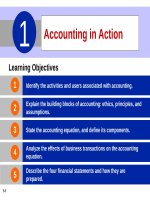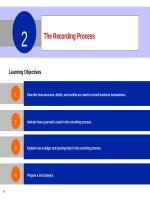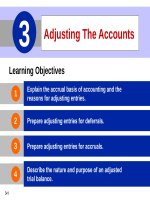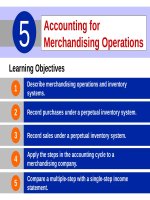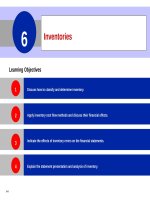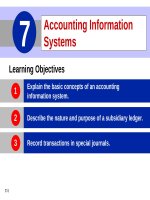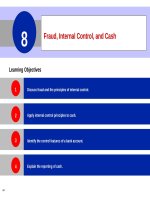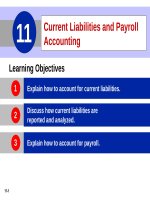Accounting principles 10e by kieso chapter 02
Bạn đang xem bản rút gọn của tài liệu. Xem và tải ngay bản đầy đủ của tài liệu tại đây (3.34 MB, 46 trang )
2-1
CHAPTER2
The Recording
Process
2-2
PreviewofCHAPTER2
2-3
The Account
Account
Record of increases and decreases
in a specific asset, liability, equity,
revenue, or expense item.
Debit = “Left”
Credit = “Right”
An Account can
be illustrated in a
T-Account form.
2-4
SO 1 Explain what an account is and how it helps in the recording process.
The Account
Debit and Credit Procedures
Double-entry system
2-5
►
Each transaction must affect two or more accounts to
keep the basic accounting equation in balance.
►
Recording done by debiting at least one account and
crediting another.
►
DEBITS must equal CREDITS.
SO 2 Define debits and credits and explain their use
in recording business transactions.
Debits and Credits
If Debits are greater than Credits, the account will have
a debit balance.
Account Name
Debit / Dr.
Credit / Cr.
Transaction #1
$10,000
$3,000
Transaction #3
8,000
Balance
2-6
Transaction #2
$15,000
SO 2 Define debits and credits and explain their use
in recording business transactions.
Debits and Credits
If Debits are less than Credits, the account will have a
credit balance.
Account Name
Transaction #1
Balance
2-7
Debit / Dr.
Credit / Cr.
$10,000
$3,000
Transaction #2
8,000
Transaction #3
$1,000
SO 2 Define debits and credits and explain their use
in recording business transactions.
Debits and Credits
2-8
Assets - Debits should exceed
credits.
Liabilities – Credits should
exceed debits.
Normal balance is on the
increase side.
SO 2 Define debits and credits and explain their use
in recording business transactions.
Debits and Credits
2-9
Owner’s investments and
revenues increase owner’s equity
(credit).
Owner’s drawings and expenses
decrease owner’s equity (debit).
SO 2 Define debits and credits and explain their use
in recording business transactions.
Debits and Credits
2-10
Purpose of earning revenues is to
benefit the owner(s).
Effect of debits and credits on
revenue accounts is the same as
their effect on Owner’s Capital.
Expenses have the opposite
effect: expenses decrease owner’s
equity.
SO 2 Define debits and credits and explain their use
in recording business transactions.
Debits/Credits Rules
Normal
Normal
Balance
Balance
Debit
Debit
2-11
Normal
Normal
Balance
Balance
Credit
Credit
SO 2
Debits/Credits Rules
Balance Sheet
Asset = Liability + Equity
Income Statement
Revenue - Expense =
Debit
Credit
2-12
SO 2 Define debits and credits and explain their use
in recording business transactions.
Debits/Credits Rules
Question
Debits:
a. increase both assets and liabilities.
b. decrease both assets and liabilities.
c. increase assets and decrease liabilities.
d. decrease assets and increase liabilities.
2-13
SO 2 Define debits and credits and explain their use
in recording business transactions.
Debits/Credits Rules
Question
Accounts that normally have debit balances are:
a. assets, expenses, and revenues.
b. assets, expenses, and owner’s capital.
c. assets, liabilities, and owner’s drawings.
d. assets, owner’s drawings, and expenses.
2-14
SO 2 Define debits and credits and explain their use
in recording business transactions.
Summary of Debits/Credits Rules
Relationship among the assets, liabilities and owner’s
equity of a business:
Basic
Equation
Illustration 2-11
Assets = Liabilities +
Owner’s Equity
Expanded
Basic
Equation
The equation must be in balance after every transaction.
For every Debit there must be a Credit.
2-15
SO 2 Define debits and credits and explain their use
in recording business transactions.
Steps in the Recording Process
Illustration 2-12
Analyze each transaction
Enter transaction in a journal
Transfer journal information to
ledger accounts
Source documents, such as a sales slip, a check, a bill, or a
cash register tape, provide evidence of the transaction.
2-16
SO 3 Identify the basic steps in the recording process.
Steps in the Recording Process
The Journal
Book of original entry.
Transactions recorded in chronological order.
Contributions to the recording process:
1. Discloses the complete effects of a transaction.
2. Provides a chronological record of transactions.
3. Helps to prevent or locate errors because the debit
and credit amounts can be easily compared.
2-17
SO 4 Explain what a journal is and how it helps in the recording process.
Steps in the Recording Process
Journalizing - Entering transaction data in the journal.
Illustration: On September 1, Ray Neal invested $15,000 cash in
the business, and Softbyte purchased computer equipment for
$7,000 cash.
Illustration 2-13
General Journal
Sept. 1
Cash
15,000
Owner’s, Capital
Equipment
Cash
2-18
15,000
7,000
7,000
SO 4 Explain what a journal is and how it helps in the recording process.
Steps in the Recording Process
Simple and Compound Entries
Illustration: On July 1, Butler Company purchases a delivery truck
costing $14,000. It pays $8,000 cash now and agrees to pay the
remaining $6,000 on account.
Illustration 2-14
General Journal
July 1
2-19
Equipment
14,000
Cash
8,000
Accounts payable
6,000
SO 4 Explain what a journal is and how it helps in the recording process.
Steps in the Recording Process
The Ledger
General Ledger contains the entire group of accounts
maintained by a company.
Illustration 2-15
2-20
SO 5 Explain what a ledger is and how it helps in the recording process.
2-21
Steps in the Recording Process
Standard Form of Account
Illustration 2-16
2-22
SO 5 Explain what a ledger is and how it helps in the recording process.
Steps
Posting –
process of
transferring
amounts from
the journal to
the ledger
accounts.
Illustration 2-17
2-23
SO 6 Explain what posting is and how it helps in the recording process.
Posting
Question
Posting:
a. normally occurs before journalizing.
b. transfers ledger transaction data to the journal.
c. is an optional step in the recording process.
d. transfers journal entries to ledger accounts.
2-24
SO 6 Explain what posting is and how it helps in the recording process.
Chart of Accounts
Accounts and account numbers arranged in sequence in which
they are presented in the financial statements.
Illustration 2-18
2-25
SO 6 Explain what posting is and how it helps in the recording process.

